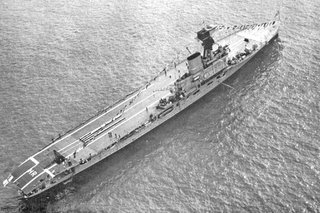HMS Hermes

HMS Hermes was the first purpose built aircraft carrier to be ordered by any navy. Previous to Hermes existing ships had been converted to allow the take off and landing of aircraft. Ordered in 1917, during the First World War, construction began in 1918 and Hermes was launched in 1919. Too late to play any part in the war, Hermes was not commissioned into the Royal Navy until 1923.
Drawing on what little practical experience of operating aircraft at sea there was, inevitably the design was flawed. She lacked operational endurance and her complement of aircraft was limited. Of more concern to her crew she had been built with similar lines to a light cruiser, a wholly unsuitable choice. The large starboard island, sited forward amidships, caused her to list, and, she was, particularly in rough weather, somewhat unstable. Despite all these faults, Hermes can be recognised as the first real aircraft carrier.
During the inter war years Hermes served in the Far East on the China Station. Twice she returned to Britain for refits in 1928 and again in 1934.

At the outbreak of the Second World War Hermes was back in Western waters, operating against the German U-boat threat. During the short-lived British Expeditionary Force's foray into continental Europe Hermes provided air cover. She continued her active service by assisting in the epic hunt across the South Atlantic sea-lanes for the German pocket battleship Admiral Graf Spee, which was wreaking havoc amongst Allied shipping.
In July 1940 while operating off Dakar (to keep an eye on French vessels) Hermes bow and flight deck were damaged in a collision with the armed merchant HMS Corfu. Putting into Freetown for basic repairs, she sailed onto Simonstown, South Africa for a more complete work including a refit. Hermes was back at sea before the end of the year.
In 1941 Hermes joined Force T, which was to operate in support of a land offensive against Italian forces in Somaliland. Later that year Hermes served in the Persian Gulf, helping to prevent any German incursions into Iraq, then in the Indian Ocean. Christmas 1941 was spent in Selborne dry dock Simonstown.
Hermes, at this time commanded by Captain R.F.J. Onslow, was back on active service in the spring of 1942 as part of Force B, based at Ceylon (Sri Lanka). On 9th April Force B was southwest of Trincomolee, attacked by a massive air strike launched by the Japanese carriers Akagi, Hiryu and Soryu. Virtually defenceless, Hermes suffered 40 hits and went to the bottom with 307 of her crew. Many of the survivors were picked up by the nearby hospital ship Vita.

Fact: Hermes badge can still be seen on the side of the Selborne dry dock wall.
Fact: The wreck of Hermes is located off Batticaloa, Sri Lanka, in the Indian Ocean.
Fact: Due to the delay in commissioning Hermes, the Imperial Japanese Navy's Hosho, commissioned in 1922, has the honour of being the first aircraft carrier actually entering service with a navy.
Fact: The Akagi had been the flagship for the Japanese attack on Pearl Harbor in December 1941.
HMS Hermes (D 95) Particulars
Hermes was built by Armstrongs of Newcastle-on-Tyne, although ordered in 1917 she was not commissioned until 1923.
Laid down: January 1918
Launched: 11 September 1919
Commissioned: July 1923
Displacement: 11,085 tons
Length: 182.27 m
Beam: 21.41 m
Draft: 5.64 m
Propulsion: Two steam turbines, 40,000 hp (30 MW)
Speed: 25 knots (46 km/h)
Complement: 700 officers and men
Armament: 6 x 5.5in (140 mm) guns, 3 x 4in (102 mm) AA guns and 8 x 12.7mm AA guns. 6 x 20 mm guns added in 1934
Aircraft: Initially 15 (Fairey III and Flycatcher) then 12 (Fairey Swordfish II or Supermarine Walrus)
Next week choose from:
USS Constitution: 'Old Ironsides', the heavy American frigate from the War
of 1812
IJN Yamato: one of two 65,000-ton behemoths built by Japan during WWII
H.L. Hunley: the first submarine to sink an enemy warship
If you'd like to see previous Warship Wednesday posts, you can choose from:
HMS Victoria: flagship of the British Mediterranean fleet, involved in one of the most notorious disasters to strike the Royal Navy.
SMS Emden: the infamous German commerce raider from WWI.
HMS Conqueror: 'Gotcha!' the sub that sank the Argentinean General Belgrano during the Falklands War.

No comments:
Post a Comment